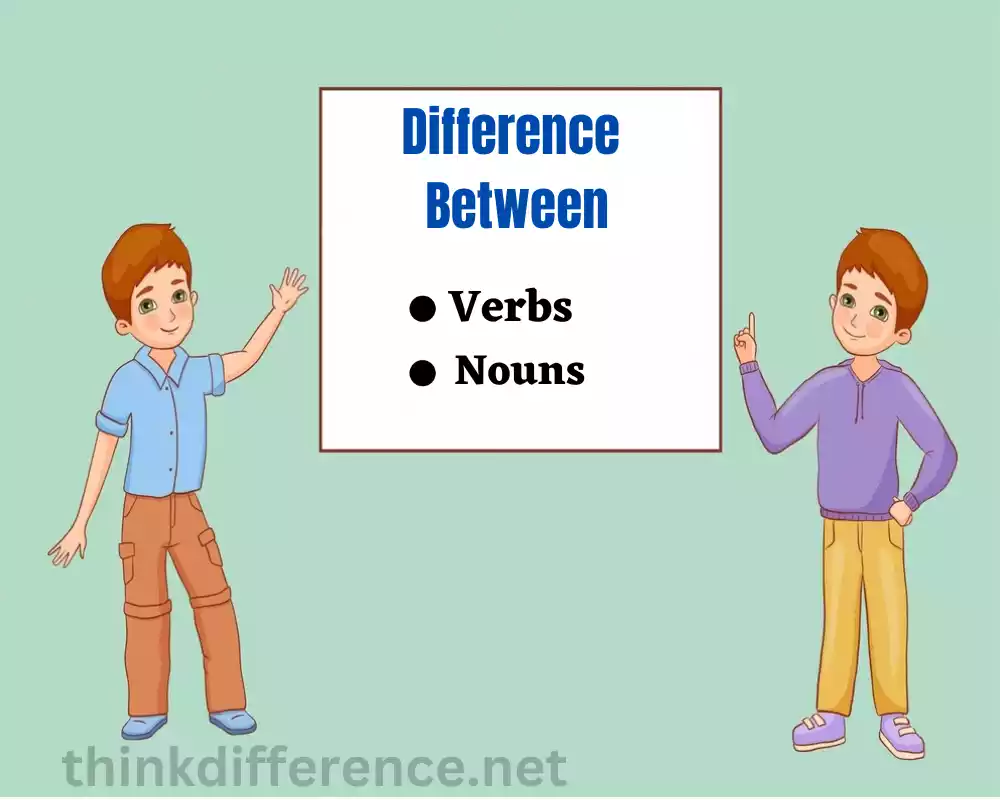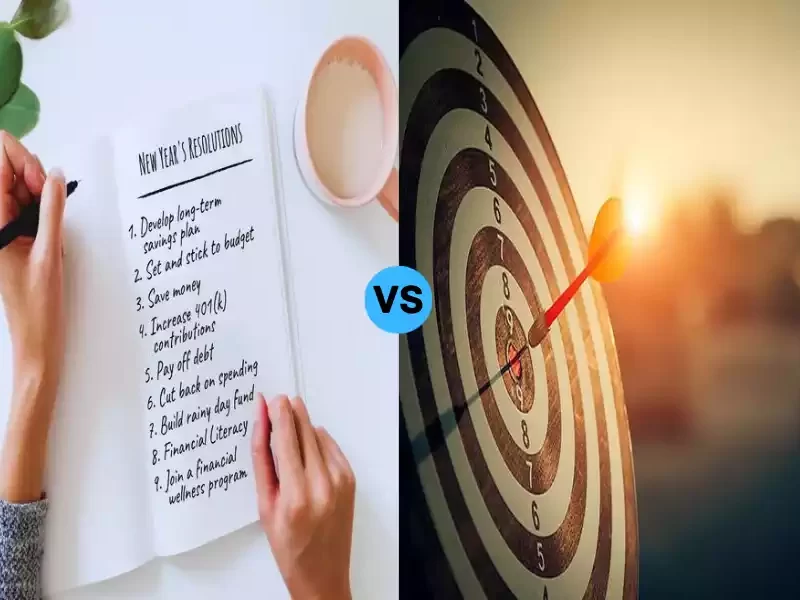Nouns and verbs form two fundamental building blocks of language. Understanding their differences as well as how each functions within sentences and communications is key for efficient writing and communicating, so in this article, we’ll take a close look at their definitions, differences, roles, and examples in writing as well as any tips on using nouns/verbs correctly for your written work and SEO improvements.
Definition of Verbs and Nouns
Verbs:
Verbs are words that express actions, occurrences, or states of being. They describe what someone or something does, experiences, or is. Verbs are essential for constructing sentences and conveying meaning.
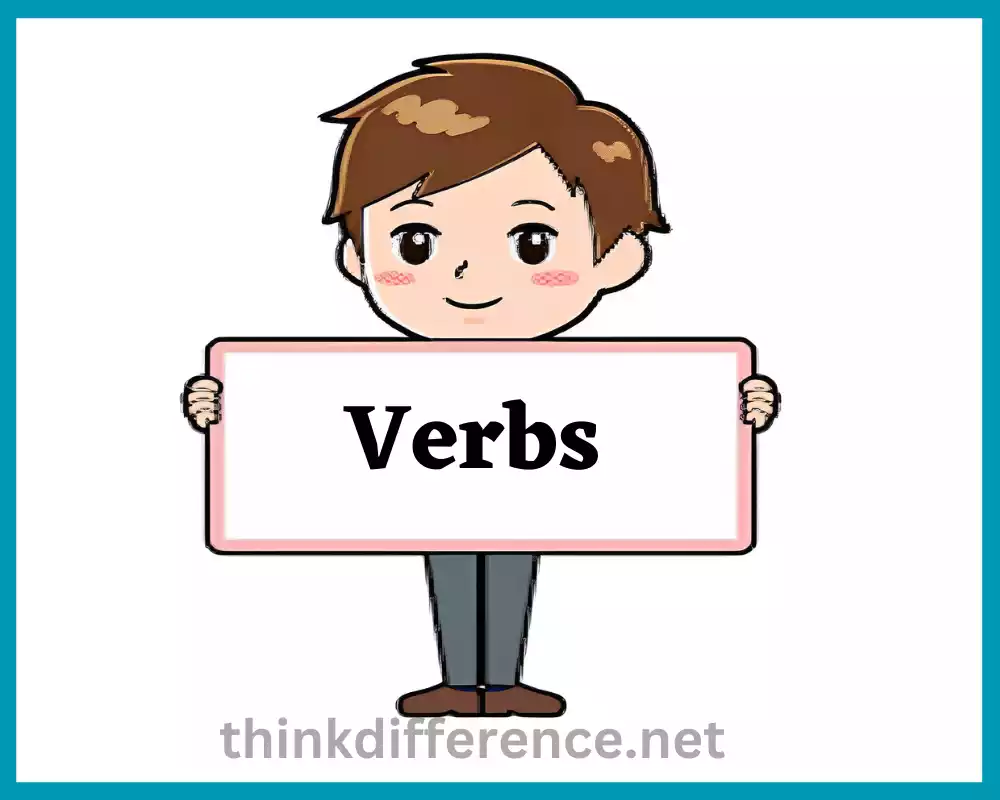
They often indicate the main action or state in a sentence and can be modified to reflect different tenses, moods or voices. Examples of verbs include “run,” “jump,” “eat,” “sleep,” “is” and “become.”
Nouns:
Nouns are words used to refer to objects, people, locations and concepts. They serve as the building blocks of sentences and provide the subjects and objects of actions.
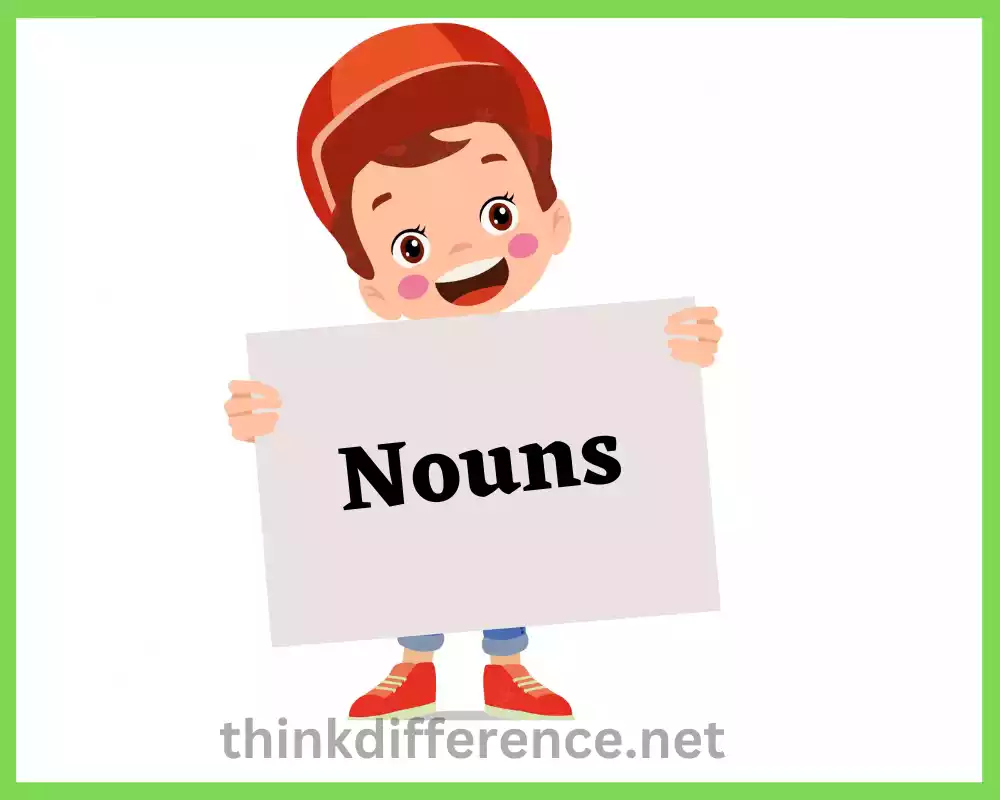
Nouns can be concrete (tangible objects) or abstract (intangible concepts). They can be singular or plural and some languages assign gender to nouns. Examples of nouns include “cat,” “table,” “book,” “love,” “idea,” “John” and “London.” Nouns play a crucial role in naming, identifying, and referring to entities in language.
Importance of understanding the difference between verbs and nouns
Understanding the difference between nouns and verbs is of vital importance for numerous reasons:
- Sentence construction: Verbs and nouns are fundamental elements of sentence structure. Knowing how to use them correctly allows you to construct grammatically accurate and meaningful sentences. Understanding the roles and functions of nouns and verbs helps ensure your sentence conveys its intended message clearly and succinctly.
- Clarity in communication: Verbs and nouns contribute to the clarity and precision of communication. Choosing the appropriate verb helps convey the specific action, state or occurrence, while selecting the right noun accurately represents the subject or object being discussed. Substituting incorrect verbs or nouns could create confusion and miscommunication.
- Expressing action and description: Verbs are essential for expressing actions, events or states of being. They allow you to communicate what someone or something does, experiences or is. Nouns enable you to name and describe people, places, things or ideas. Understanding the distinction between verbs and nouns helps you express yourself effectively, providing details and descriptions as needed.
- Writing and speaking skills: Proficiency in using verbs and nouns enhances your overall writing and speaking skills. By employing a wide range of verbs and nouns, you can create vivid descriptions, paint a clear picture and engage your audience. A rich vocabulary of verbs and nouns allows you to communicate with precision, variety and depth.
- Avoiding errors and misunderstandings: Erroneous use of nouns and verbs can result in both grammatical errors and confusion, with making mistakes such as mistaking using adjectives for verbs or vice versa affecting the entire sentence’s meaning. Understanding the differences between verbs and nouns helps you avoid common errors, such as subject-verb agreement mistakes or using nouns as verbs incorrectly.
Grasping the distinction between verbs and nouns is crucial for constructing coherent sentences, ensuring clarity in communication, expressing action and description, developing strong language skills and avoiding errors and misunderstandings. It lays the foundation for effective language use and facilitates effective communication in both written and spoken forms.
Characteristics of Verbs
Verbs possess several key characteristics that distinguish them within language. Understanding these characteristics helps in identifying and using verbs effectively. Some of the main characteristics of verbs are:
- Action-oriented nature: Verbs primarily express actions, events, or processes. They describe what someone or something does or experiences. For example, “run,” “jump,” “sing,” and “write” are all action-oriented verbs.
- Tense and time expression: Verbs have the ability to indicate the time or tense of an action or state. They can be modified to reflect past, present or future time, allowing for a temporal understanding of events. Example: “walk” can be transformed into “walked” (past tense), “walks” (present tense) or even “will walk”.
- Verb forms and conjugation: Verbs can take various forms depending on the tense, mood, voice or aspect being expressed. They undergo conjugation to match the subject and sometimes agree with other elements in the sentence. Example for instance,”to be” can change into either am, is or are depending upon its subject and verb tense (for instance “I am”, “he is”, and/or “they are”).
- Role in sentence structure: Verbs often serve as the main component of a sentence, indicating the action or state being described. They may be accompanied by other elements such as subjects, objects, adverbs or complements to provide additional information or clarification. For instance, in the sentence “She plays the piano beautifully,” the verb “plays” conveys the action, while “she” is the subject and “the piano beautifully” provides additional details.
- Ability to be modified by adverbs: Adjectival terms provide further details regarding how an action should be performed. Adverbs describe aspects such as time, place, manner, degree or frequency. As evidenced in this sentence: He speaks fluently.” Here the verb to speak (speaks) has been altered by adding in the adjective fluently as an indicator of its method of execution.
- Ability to form gerunds and infinitives: Verbs can be transformed into gerunds or infinitives. Gerunds function as nouns and end in “-ing” (e.g., “swimming,” “running”). Infinitives may serve as adjectives, nouns and adverbs and are typically prefixed with “to.” For instance: “to eat,” and “to go.” This flexibility allows verbs to be used in different grammatical contexts.
The characteristics of verbs include their action-oriented nature, ability to express tense and time, forms and conjugation, role in sentence structure, modification by adverbs and versatility in forming gerunds and infinitives. Understanding these characteristics is crucial for effectively using verbs in language.
Characteristics of Nouns
Nouns possess distinct characteristics that set them apart within language. Understanding these characteristics helps in identifying and using nouns effectively. Here are some of the main characteristics of nouns:
- Naming function: Nouns serve the primary purpose of naming and identifying people, places, things or ideas. They provide labels or designations for entities, enabling communication about specific objects or concepts. Nouns used as examples include “dog,” “book” and “love. “
- Referential nature: Nouns function as referents, representing or pointing to people, places, things or ideas. They help establish connections between language and the real world, allowing us to talk about specific entities or abstract concepts. As an example, “tree” refers to an object existing within our physical world.
- Singular and plural forms: Nouns may refer to both singular (referring to one specific entity) and plural entities, with plurality typically indicated by adding an “s” or an “es”. Irregular plural forms exist too (for instance when “child” changes to “children”) for instance when cats is plural and cats is singular. For instance when used singularly cat is considered singular but when pluralized “cats” becomes plural.
- Gender: Certain languages distinguish nouns into gendered categories such as feminine, masculine or neutral nouns. Gender may determine the form of associated articles, adjectives or pronouns. English doesn’t typically assign gendered nouns with some notable exceptions such as actor (masculine) and actress (feminine).
- Role as subjects and objects: Nouns often function as the subject or object of a sentence, indicating who or what performs an action or receives the action. The subject typically initiates the action, while the object is affected by it. Example sentence: In “The cat chased the mouse”, cat is considered as subject, while mouse serves as object.
- Modification by adjectives: Nouns may be modified with adjectives to provide additional details regarding their subject matter. Adjectives describe qualities, characteristics or attributes of the noun. As an example, when speaking of beautiful flowers, “flower” becomes modified by its adjective counterpart: beautiful.
- Possibility of possessive forms: Nouns can be transformed into possessive forms to indicate ownership or possession. This is achieved by adding an apostrophe and “s” (‘s) to the noun. For example, “John’s book” indicates that the book belongs to John.
Understanding these characteristics of nouns helps in recognizing and using them accurately in sentences. Nouns play a crucial role in naming, representing and referring to entities, making them essential components of language.
Differences between Verbs and Nouns
Nouns and verbs are both essential elements of language. Understanding their differences is integral for creating sentences with meaning. Here are a few key distinctions:
1. Function and purpose:
- Verbs: Verbs express actions, occurrences or states of being. They describe what someone or something does or experiences. Verbs convey the main action or state in a sentence.
- Nouns: Nouns serve as the names of people, places, things or ideas. They represent and identify entities in language. Nouns function as subjects or objects in a sentence.
2. Grammatical features:
- Verbs: Verbs can be modified to indicate different tenses, moods or voices. They undergo conjugation to match the subject and agree with other elements in the sentence.
- Nouns: Nouns can be singular or plural and some languages assign gender to them. Nouns can be modified by articles, adjectives or possessive forms to provide more information or context.
3. Sentence roles:
- Verbs: Verbs often serve as the main component of a sentence, expressing the action or state. They indicate what is happening or being described.
- Nouns: Nouns represent the subject or object of a sentence. They provide the entities or things that the action is performed on or is happening to.
4. Examples:
- Verbs: run, jump, eat, be, become.
- Nouns: cat, table, book, lover and idea.
5. Modification:
- Verbs: Verbs may be modified with adverbs for added information about how an action will take place.
- Nouns: Adjectives can add depth to a word by providing extra details about it.
6. Sentence construction:
- Verbs: Verbs are essential for constructing meaningful sentences. They provide the action or state that drives the sentence’s meaning.
- Nouns: Nouns are crucial for identifying the subject or object of a sentence. They provide the entities being referred to or acted upon.
Understanding the differences between verbs and nouns allows for proper sentence construction, clear communication and accurate representation of actions, objects and concepts. It helps in developing strong language skills and avoiding grammatical errors or misunderstandings.
Role of Verbs and Nouns in Sentence Structure
Verbs and nouns play essential roles in the structure of sentences. Each contributes to the overall meaning and helps convey information about the subject, action and objects involved. Let’s delve deeper into how nouns and verbs influence sentence structures:
Verbs:
Verbs serve as the backbone of a sentence and are responsible for expressing actions, occurrences or states of being. They typically indicate what someone or something does or experiences. The key roles of verbs in sentence structure include:
- Predicate: Verbs form the predicate of a sentence, which provides information about the action or state of the subject. The verb often functions as the main component of the predicate, conveying the primary action or state.
- Tense and time: Verbs indicate the time or tense of an action, allowing us to express whether an action occurred in the past, is happening in the present or will occur in the future. They provide a temporal frame of reference within a sentence.
- Agreement with subject: Verbs agree with the subject of a sentence in terms of number and person. The syntax of verbs may change according to whether they refer to subjects that are singular or plural and whether or not first person perspective or third person is involved.
- Voice and mood: Verbs can also be active or passive voice, indicating whether the subject is performing the action or receiving it. Additionally, verbs can convey different moods, such as indicative, imperative, subjunctive or conditional, to express certainty, command, hypothetical situations and more.
Nouns:
Nouns provide the subjects and objects of a sentence, representing people, places, things or ideas. They play crucial roles in sentence structure, including:
- Subject: Nouns often function as the subject of a sentence, which is the entity performing the action or experiencing the state expressed by the verb. The subject serves as the main topic of the sentence and helps to establish the overall meaning.
- Object: Nouns can also act as objects within a sentence, receiving the action of the verb. There are two types of objects:
- Direct object: It directly receives the action of the verb.
- Indirect object: It receives the direct object or benefits from the action.
- Complement: Nouns can function as complements, providing additional information about the subject or object. For example, a noun can serve as a predicate noun or predicate nominative, renaming or describing the subject after a linking verb.
- Determiners and modifiers: Nouns often include descriptors (such as demonstratives, articles and possessives ), determiners and modifiers to provide more exact data, explain relationships or clarify subjects.
Understanding how verbs and nouns play into sentence structure is integral for producing accurate and effective texts. By recognizing how verbs express actions and states and how nouns represent entities, one can effectively convey information and communicate ideas in a coherent manner.
Common Mistakes with Verbs and Nouns
People make several common errors when using nouns and verbs in communication, leading to grammar issues or inconsistent messages.
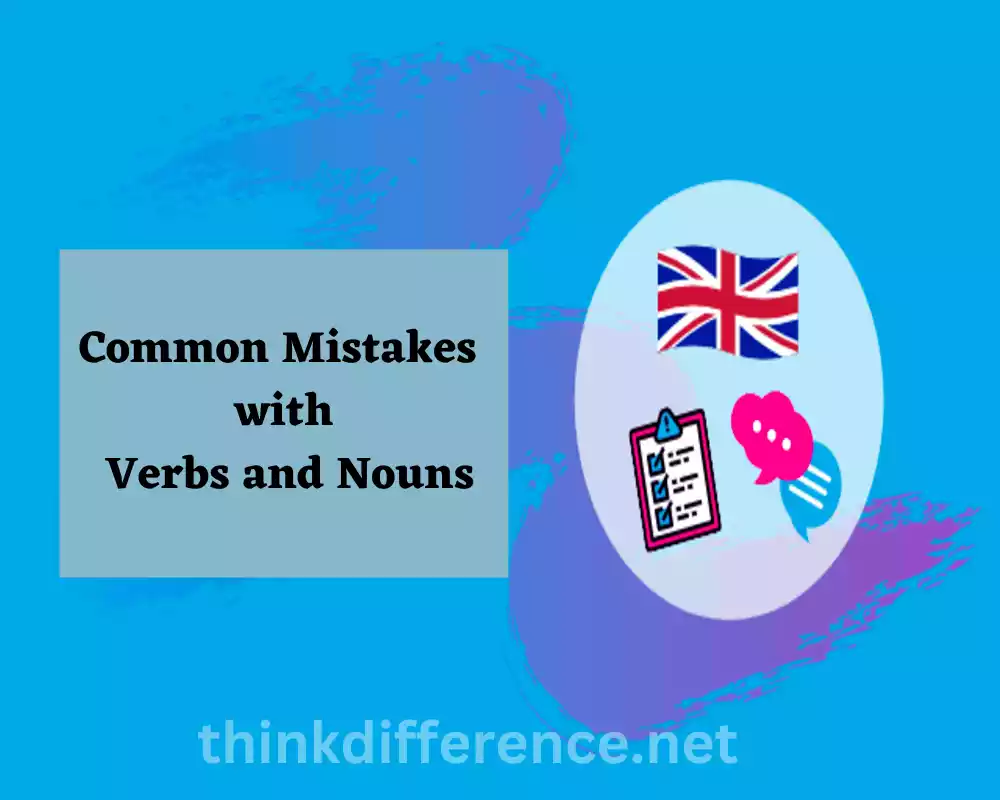
Below are a few frequently committed mistakes:
- Subject-verb agreement: One common mistake is failing to ensure that the subject and verb agree in number. For example, using a singular verb with a plural subject or vice versa. Correcting this error involves matching singular subjects with singular verbs and plural subjects with plural verbs.
- Using nouns as verbs: Sometimes, people mistakenly use nouns as verbs, creating awkward or incorrect sentences. Erroneously using nouns as possible verbs leads to incorrect grammar. They should always use verbs instead for clarity. For instance, saying “He tabled the proposal” instead of “He presented the proposal.”
- Using verbs as nouns: Another frequent error involves misusing verbs as nouns, leading to incorrect sentence structure or leading to unnecessary confusion. An example would be using “decision” as an adjective instead of as a noun e.g. “run.”
- Incorrect verb tense: Mistakes related to verb tense can occur when the wrong tense is used, resulting in inconsistencies or unclear timelines. It is important to choose the appropriate verb tense to match the intended meaning and time frame of the action or state being described.
- Improper use of irregular verbs: Verbs that are irregular have various versions for both past tense and participle forms. Using incorrect ones could result in errors like saying, for instance: “I swam” instead of “I swam” or “I runned” instead of “I ran”.
- Lack of agreement between pronouns and nouns: Pronouns must agree with the nouns they refer to in terms of number, gender and person. Failing to ensure this agreement can result in confusion or grammatical errors. For instance, using “he” instead of “they” to refer to a plural noun.
- Misusing possessive forms: Mistakes with possessive forms occur when the apostrophe is misplaced or omitted. For example, writing “its” instead of “it’s” for the contraction of “it is,” or using “John’s” instead of “Johns'” to indicate something belongs to multiple Johns.
- Overusing or omitting articles: “Articles,” such as “a,” “an,” and “the,” can be used to denote generalization or specificity for nouns. Errors can occur when articles are overused or omitted, leading to confusion or improper sentence structure. It is important to use the appropriate article based on the context and intended meaning.
To avoid these common mistakes, it is helpful to review grammar rules, proofread carefully, and practice using verbs and nouns correctly in context. Consulting grammar resources or seeking feedback from native speakers or language experts can also be beneficial in improving accuracy and proficiency.
Tips for Using Verbs and Nouns Correctly
Accurate verb and adjective usage is crucial to effective and clear communication, here are a few suggestions on how you can utilize words and verbs appropriately:
- Understand the roles: Familiarize yourself with the functions of verbs and nouns in sentence structure. Learn how verbs express actions or states, while nouns represent people, places, things or ideas.
- Identify subject and verb agreement: Ensure that the subject and verb agree in number. A singular subject should be coupled with a singular verb, while plural subjects require plural verbs.
- Use appropriate verb tenses: Choose the correct verb tense to match the intended meaning and time frame. Consider whether the action is in the past, present or future and use the corresponding verb form.
- Be mindful of irregular verbs: Pay attention to irregular verbs that have unique forms for past tense and past participle. Familiarize yourself with their irregularities to use them correctly in sentences.
- Watch for noun-verb confusion: Be careful not to use nouns as verbs or vice versa. Use the appropriate verb form to express actions and the appropriate noun form to represent entities or objects.
- Pay attention to pronoun-noun agreement: Ensure that pronouns agree with the nouns they refer to in terms of number, gender and person. Use the correct pronoun form to maintain consistency and clarity.
- Use articles appropriately: Determine whether a noun requires an article (such as “a,” “an,” or “the”) based on its specificity or generalization. Consider the context and intended meaning when choosing the appropriate article.
- Proofread and revise: Take the time to review your writing and check for any errors or inconsistencies related to verbs and nouns. Proofreading allows you to identify and correct any mistakes before finalizing your communication.
- Consult grammar resources: Refer to grammar guides, style manuals or language resources to reinforce your understanding of verb and noun usage. These resources provide explanations, examples and additional tips to improve your language skills.
- Seek feedback: When possible, seek feedback from native speakers, language instructors or proficient writers. Their insights and corrections can help you refine your use of verbs and nouns and improve your overall language proficiency.
Remember that using verbs and nouns correctly takes practice and continuous learning. By applying these tips and actively engaging with the language, you can enhance your ability to communicate accurately and effectively.
Enhancing Your Writing with Verbs and Nouns
Utilizing verbs and nouns effectively in your writing will significantly enhance its clarity, impact and effect. Here are a few helpful strategies for using both nouns and verbs more efficiently:
- Choose strong verbs: Opt for vivid and precise verbs that convey the desired action or state effectively. Instead of employing generic verbs such as “do” or “make,” switch up your verb usage so as to more vividly engage readers’ imaginations. Instead of “walked”, try substituting “strollled” or “sprinted”. Doing this can add additional clarity and enrichment to your writing.
- Be specific with nouns: Make use of specific words when giving an accurate and comprehensive description of an object or entity you’re discussing. This allows for clear communication. Rather than using broad terms like “thing” or “stuff,” use concrete nouns that precisely identify what you are discussing. For instance, replace “thing” with “gadget” or “device” to add specificity.
- Utilize noun phrases: Constructing noun phrases can add complexity and depth to your writing. Instead of using a single noun, combine it with descriptive words or phrases to create more vivid and informative noun phrases. For example, instead of saying “car,” you can write “sleek silver sports car.”
- Show, don’t tell: Use strong verbs and vivid nouns to create sensory and visual imagery in your writing. Instead of telling the reader what is happening, show it through dynamic verbs and descriptive nouns. This engages the reader’s imagination and makes your writing more engaging and memorable.
- Vary sentence structure: Experiment with different sentence structures to add variety and rhythm to your writing. Make use of both short and long sentences, being mindful to include verbs, subjects and nouns at different points within each one. This creates a more dynamic flow and prevents monotony.
- Consider connotation: Take note of the meanings of particular verbs and nouns. Choose words that evoke the desired emotional or intellectual response from your readers. For example, selecting “whispered” instead of “said” can add a sense of secrecy or intimacy to your writing.
- Edit for conciseness: Review your writing and eliminate unnecessary or repetitive verbs and nouns. Clear and concise writing is often more impactful. Trim any wordiness or redundancy to ensure that every verb and noun serves a purpose and contributes to the overall meaning.
- Read widely: Expand your vocabulary and exposure to different writing styles by reading a variety of literature, articles and other written works. Pay attention to how skilled writers effectively use verbs and nouns to convey their ideas and evoke emotions.
- Revise and proofread: Always revise and proofread your writing to ensure that your verbs and nouns are used accurately and effectively. Check for errors in subject-verb agreement, noun-verb consistency and noun-pronoun agreement. Polish your writing to make it clear, concise and impactful.
By implementing these tips and practicing their application in your writing, you can enhance the power and effectiveness of your words. Verbs and nouns are essential building blocks of language and utilizing them thoughtfully and skillfully can elevate your writing to a higher level.
Conclusion
Verbs and Nouns form the backbone of any language, enabling effective communication and expression. Understanding the different types of verbs and nouns, their usage, and proper agreement between them is vital for crafting clear and meaningful sentences. By mastering these elements, you’ll elevate your language proficiency and confidently navigate the intricacies of grammar.

